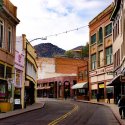Smooth Sailing in Newport, Rhode Island
By Christine SteeleSavoring the history and flavors of this seaside town
Growing up in New England, I was certainly familiar with Newport, Rhode Island, the seaside town famous for its sailing history and Gilded Age mansions—summer homes to the original old money families like the Vanderbilts and the Astors. Years back, I had attended the Newport Folk Festival, but hadn’t spent much time exploring the town before I moved away from the area. Feeling like I’d missed out on a promising destination, I took advantage of a return trip visiting family to soak in some sightseeing in Newport.
Along the ocean’s edge
My first stop was the famed Cliff Walk, a 3.5-mile stroll on a mostly flat concrete path that runs along the spectacular cliffs that tower above the ocean’s edge. I could taste the salt air as I took in the dazzling views all around me—the vast Atlantic Ocean on one side, and the elaborate mansions on the other, with their expansive lawns stretching all the way to the shoreline. It was not all flat and easy. I found myself treading carefully along some rocks, and climbing over boulders in some of the narrower stretches of the trail. It turned out to be great exercise.
Seafood with a side of history
After working up an appetite, I headed for the White Horse Tavern. Built in the mid-1600s, it is believed to be the oldest tavern building in the country, and the 10th oldest in the world. Not just old, it has a storied past that involves a notorious pirate of the Red Sea, as well as councilors who charged their meals to the public treasury. The tavern was full of Colonial charm both inside and out, with its red clapboard siding, gambrel roof, wide wooden beams, antique portraits on the walls, and giant fireplaces.
I sat at the bar and ordered what I came for—fresh Rhode Island seafood. I started with a selection from the raw bar—a shellfish plate for one that included three New England oysters, three Narragansett Bay Littleneck Clams, and two shrimp, all served with lemon, cocktail sauce, and a delicious mignonette dressing. The taste of the sea went perfectly with my pint of American Strong Ale from Rhode Island’s Whaler’s Brewing Company.
I slurped up those oysters wishing I had ordered the larger shellfish plate for two! But I needed to save room for my other New England favorite—clam chowder. No one makes real New England Clam Chowder west of the Mississippi, where I now live, so I savored each spoonful, wishing I had ordered a bowl instead of a cup. Satisfied, but not overly stuffed, I headed out to tour those mansions Newport is famous for.
The Breakers
The Breakers is the grandest of the Newport Mansions. Commissioned in 1893 by steamship and railroad tycoon Cornelius Vanderbilt, it is more like a European palace than a cottage. Filled with chandeliers, ornate gold woodwork throughout, and Michelangelo-inspired murals, it is the picture of Gilded Age opulence. Not surprising since it was inspired by the 16th-century palaces of Italy. Gold, gold, and more gold, the 70-room Italian Renaissance-style palazzo mansion was built with the finest materials—marble imported from Italy, and not just for the floors. There was Italian marble on the walls of the billiard room, for the fireplace hearths and mantels, and even an Italian marble bathtub, carved from a single slab, with both freshwater and seawater taps.
Vroom, vroom
One place I couldn’t resist was the Audrain Automobile Museum, a unique museum showcasing some of the rarest vehicles ever made. The museum happened to be featuring an exhibit called “Horseless to Horsepower: Gilded and Golden Age Automobiles,” during my visit, telling a bit more of the Gilded Age story. In fact, it was there I learned that Newport is the birthplace of motor racing in America—founded by none other than Willie K. Vanderbilt.
The collection included a 1900’s Locomobile, an open-air, horseless carriage—a steam-powered two-seater designed by the Stanley Brothers, (the brothers known for the Stanley Steamer). My favorite, though, wasn’t a car at all, but the 1938 Brough Superior motorcycle with petrol tube sidecar. The sleek black-and-chrome bike is the Rolls Royce of motorcycles and was low enough for me to sit on. Tempting, but I didn’t. Other exotic cars in the collection included a 1923 Rolls Royce, 1936 Bugatti, a 1923 Duesenberg, and a 1910 Pierce Four motorcycle. At first glance, you might think this two-wheeler looks like a modern electric bicycle, but the Pierce Four was a cutting-edge, high-quality, luxury vehicle from a maker favored by Hollywood stars, presidents, tycoons, and royalty alike.
Thames Street and Bowen’s Wharf
Newport is a walkable city, and after a few hours wandering through mansions and museums, I needed some fresh air. So, I headed downtown to Thames Street and Bowen’s Wharf to do a little shopping and take in the beautiful views of the boats in the harbor. It was there that I happened upon a shop with some souvenirs from the mansions. I picked up a refrigerator magnet to add to my collection back home. It featured a replica of a beautiful portrait that hung in one of the mansions of a Gilded Age socialite painted by John Singer Sergeant.
With so much history—Newport has more than 100 places in the National Register of Historic Places—there was far more than I could take in on a weekend getaway, so I know a return trip is a must.
If you’re itching for more history, take A Fresh Look at the First State.


